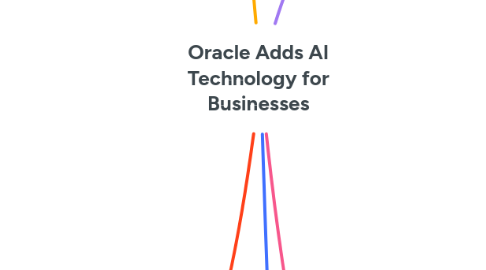
1. Change Resistance
1.1. Who is resisting and why?
1.1.1. Businesses both familiar and unfamiliar with Oracle could initially be resistant to the new generative AI feature because of the popular concern of data privacy.
1.1.2. Employees may be resistant to change because of lack of understanding around the benefits that generative AI tools have. Lack of staff training reduces confidence in ones ability to utilize the software on a proficient level. Additional misunderstandings surrounding the advancements in the sofware can also harbor concerns regarding employment.
1.2. Methods for dealing with resistance
1.2.1. Addressing resistance reqires a multifaceted approach. By starting out with training employees, you equip them with the necessary skills and knowledge needed to troubleshoot, coach, teach, train, and provide feedback.
1.2.2. Educating both employees and customers about the benefits of generative AI fosters understanding and buy-in.
1.2.3. Demonstrating the value of generative AI as a tool that will enhance their work through practical examples is an effective strategy in dealing with resistance.
1.2.3.1. Actively engaging with your team, involving them and businesses in the change process is crucial. The intentional engagement allows organizations the opportunity to tap into valuable insights and ensure smoother transitions. However, there is a potential risk: some companies may opt for cost-cutting measures, such as laying off employees without adequate training, which could have long-term repercussions.
2. Methods best for introducing change?
2.1. Lewin's 3-Stage Model
2.1.1. The most effective way for Oracle to introduce this change is by using Lewin’s 3-stage model for change. In the unfreeze stage, Oracle would first analyze their current product and then determine what improvements are needed. During the change stage, Oracle integrates the improvements while getting employees, shareholders, and customers on board with the change. Lastly, in the refreeze stage, Oracle would make final adjustments and edits to the new program after obtaining feedback from employees, shareholders, and customers.
2.2. Introduce Oracle's advancements through phased education, pilot programs, stakeholder collaboration, clear communication, ongoing support, integration assistance, and performance monitoring. This comprehensive approach ensures effective adoption and utilization of generative AI and sustainability offerings across diverse business functions.
2.3. Kotter's 8-Step Model
2.3.1. Kotter's 8-step model is applicable for introducing Oracle's generative AI and sustainability offerings. Establish urgency, form a coalition, and communicate vision and strategy. Empower employees, celebrate early wins, and address challenges. Consolidate gains, embed changes in culture, and ensure ongoing improvement. This structured approach fosters successful adoption and integration of new technologies and practices across the organization.
3. Nature Of Change
3.1. What is the change?
3.1.1. Oracle is Adding Generative AI Tools for Businesses
3.1.1.1. By choosing to add generative AI tools to their suite of software, Oracle aims to aid businesses in tracking their environmental impact. The tools offered will help companies increase sustainability and inspire action towards decreasing their carbon footprint.
3.2. How is the change being implemented?
3.2.1. This change is being introduced with a common architecture for generative AI that is being integrated across the Oracle ecosystem from its Autonomous Database to Fusion SaaS application, within their cloud data center and on-premises environment.
4. Stakeholders
4.1. Oracle Corporation, Customers, Investors, Employees, Industry Partners, Environmental Advocacy Groups,
4.1.1. Who is benefitting?
4.1.1.1. Oracle Corporation
4.1.1.1.1. Oracle stands to benefit financially from the adoption of its new offerings. Increased demand for its Fusion Cloud Applications, driven by the integration of generative AI capabilities, could lead to higher revenues and market share. Additionally, offering sustainability solutions enhances Oracle's reputation as a socially responsible company, potentially attracting more customers and investors
4.1.1.2. Customers
4.1.1.2.1. Companies using Oracle's Fusion Cloud Applications benefit from the added functionality of generative AI, which can improve productivity, reduce costs, and enhance decision-making processes across various business functions. The sustainability offering helps them assess and mitigate their environmental impact, aligning with corporate social responsibility goals and regulatory compliance requirements.
4.1.1.3. Environmental Advocacy Groups
4.1.1.3.1. Organizations focused on sustainability benefit from Oracle's efforts to provide tools that enable companies to assess and reduce their environmental impact. These offerings support the goals of environmental advocacy groups by promoting corporate sustainability and responsible business practices.
5. Methods for dealing with each stakeholder goup
5.1. Oracle Corporation
5.1.1. Direct communication: Regular updates on progress and benefits. Feedback channels: Solicit input on features and improvements. Training and support: Ensure internal teams are well-equipped to promote and support the offerings.
5.2. Customers
5.2.1. Education: Provide comprehensive training and resources on using the new features effectively. Feedback mechanisms: Gather feedback to address concerns and enhance user experience. Customization options: Offer flexibility to tailor solutions to specific needs.
5.3. Investors
5.3.1. Transparency: Communicate the strategic importance and potential impact of the offerings on financial performance. Demonstrated value: Showcase how the new offerings contribute to revenue growth and market differentiation. Engagement: Provide opportunities for investors to learn more about the technology and its market potential.
5.4. Employees
5.4.1. Training programs: Offer comprehensive training on using and supporting the new offerings. Incentives: Provide recognition or rewards for employees who actively contribute to the success of the initiatives. Open communication: Foster a culture of feedback and transparency to address concerns and build buy-in.
5.5. Industry Partners
5.5.1. Collaboration: Work closely with partners to integrate the new offerings into joint solutions. Co-marketing opportunities: Highlight joint successes and promote the value of the integrated offerings. Support and training: Offer assistance to partners in adopting and promoting the new technologies.
